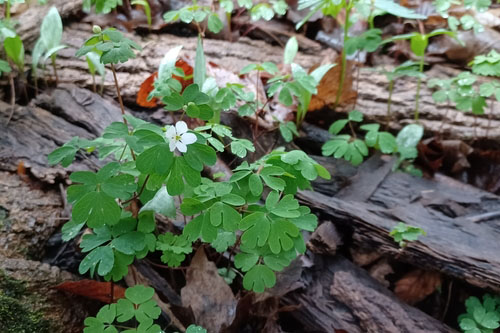Eastern False Rue-anemone
Species information

The following is a report on progress made towards the protection and recovery of Eastern False Rue-anemone (Enemion biternatum) in Ontario from 2007 to 2023, based on Ontario’s species-specific recovery policy. This report meets the legislative requirement for a review of progress under the Endangered Species Act, 2007 (ESA or “the Act”). Eastern False Rue-anemone is listed as threatened on the Species at Risk in Ontario (SARO) List under the ESA.
Eastern False Rue-anemone has been classified as a species at risk since April 24, 2004. It was originally classified under the name “False Rue-anemone” as a special concern species and was subsequently re-classified and listed as threatened under the ESA when it came into force in June 2008. The species’ common name was updated on the SARO List from “False Rue-anemone” to “Eastern False Rue-anemone” on January 26, 2022, to be consistent with recent nomenclatural changes. The species was then re-classified as a special concern species on January 29, 2024, following changes to species’ assessment criteria used by the Committee on the Status of Species at Risk in Ontario
Eastern False Rue-anemone has been protected from being killed, harmed, harassed, captured or taken since 2008.
In addition, the habitat of Eastern False Rue-anemone has been protected from being damaged or destroyed since 2013.
The species-specific recovery policy for Eastern False Rue-anemone, known as the government response statement (GRS) was published in 2019 and includes the government’s recovery goal for the species and the actions and priorities it intends to lead or support to help achieve that goal. The GRS considers science advice provided in the recovery strategy (published in 2018), regarding things such as the species biology, habitat needs, threats to survival, knowledge gaps and approaches to recovery, when developing recovery actions for the species. As legislated in the Act, the purpose of this Review is to report on progress made towards implementing the protection and recovery actions in the GRS. The review can also help identify opportunities to adjust and adapt the implementation of protection and recovery actions to achieve the recovery goal for the species.
Further information about Eastern False Rue-anemone including the threats that it faces and actions being taken to help protect and recover this species, is available on the Government of Ontario webpage for Eastern False Rue-anemone. A summary on the progress towards the protection and recovery of Eastern False Rue-anemone and an annual update on the broader species at risk program (i.e. the Introduction to the 2024 Review of Progress report) is available on the Review of Progress towards the Protection and Recovery of Ontario’s Species at Risk webpage.
Snapshot: Progress towards the protection and recovery of Eastern False Rue-anemone
Progress towards meeting the recovery goal
- The recovery goal in the government response statement (GRS) for Eastern False Rue-anemone in Ontario is to “maintain existing populations within the species’ distribution, promote their viability, and where feasible, enable natural increases in abundance.”
- Progress has been made towards implementing all of the government-led actions. Progress has been made towards implementing all of the government-supported recovery objectives and several of the associated actions. Examples of progress include:
- conducting presence surveys at locations where predictive modeling indicates Eastern False Rue-anemone is likely to occur
- developing, implementing and evaluating site management plans to maintain or improve the quality of Eastern False Rue-anemone habitat and the viability of populations
- promoting awareness about Eastern False Rue-anemone among land owners, land managers and land users
- In alignment with the GRS, further work is required to:
- collaborate with partners and other jurisdictions to increase understanding of Eastern False Rue-anemone population viability and best practices for improving it
- implement approaches to avoid or reduce impacts of recreational activities on Eastern False Rue-anemone and its habitat
- work with land owners and community partners to support the securement of habitat of Eastern False Rue-anemone through existing land securement and stewardship programs
Occurrences and distribution
- Nine populations of Eastern False Rue-anemone have been documented in southwestern Ontario. Currently, six of these populations
footnote 2 are extantfootnote 3 one is considered historicalfootnote 4 and two are ranked failed to findfootnote 5 . Since 2008, the status of one population changed from extant to historical, three populations have changed from historical to extant based on new observations and two populations changed from historical to failed to find since, despite searches, plants of the species were not re-found. - Through a project funded by the Species at Risk Stewardship Program, Eastern False Rue-anemone was found at three new sites close to a known population of the species.
Government-supported stewardship projects
- Through the Species at Risk Stewardship Program, the Government of Ontario has enabled its stewardship partners to conduct five projects (by providing $121,198 in funding) that have supported the protection and recovery of multiple species at risk, including Eastern False Rue-anemone (e.g., landscape-level habitat restoration, or outreach and education focusing on a certain group of species such as those present in a local region).
- The government’s support helped its stewardship partners to involve seven individuals who volunteered 5,578 hours of their time towards protection and recovery activities for species at risk, including Eastern False Rue-anemone. The estimated value of these voluntary contributions, as well as additional funding and in-kind support, is $613,848.
- Stewardship partners reported providing outreach on multiple species at risk, including Eastern False Rue-anemone, to 601 individuals.
Supporting human activities while ensuring appropriate support for species recovery
- To date, no permits have been issued for this species.
- Eleven activities have been undertaken in accordance with a conditional exemption that requires registration under the ESA. The activities followed either the conditional exemption for ‘species protection, recovery activities’ (section 23.17) or ‘threats to human health and safety, not imminent’ (section 23.18) under Ontario Regulation 242/08 of the ESA.
Reporting on the progress towards the protection and recovery of Eastern False Rue-anemone
Recovery goal
The government’s goal for the recovery of Eastern False Rue-anemone is to maintain existing populations within the species’ distribution, promote their viability, and where feasible, enable natural increases in abundance.
The implementation of government-led and government-supported actions demonstrates progress towards reaching the desired objectives and the recovery goal set out in the GRS.
Progress towards implementing government-led actions
Progress has been made towards implementing all government-led actions identified in the GRS. Common actions for the government to lead as it works towards achieving a species’ recovery goal include:
- Continue to implement the Ontario Invasive Species Strategic Plan (2012) to address the invasive species (e.g., Goutweed) that threaten Eastern False Rue-anemone.
- Work with partners and stakeholders to support pollinator health in Ontario through actions such as integrated pest management and education.
- Educate other agencies and authorities involved in planning and environmental assessment process on the protection requirements under the ESA.
- Encourage the submission of Eastern False Rue-anemone data to the Ontario’s central repository through the citizen science project that they receive data from (i.e., iNaturalist.ca) and directly through the Natural Heritage Information Centre.
- Undertake communications and outreach to increase public awareness of species at risk in Ontario.
- Continue to protect Eastern False Rue-anemone and its habitat through the ESA.
- Support conservation, agency, municipal and industry partners, and Indigenous communities and organizations to undertake activities to protect and recover Eastern False Rue-anemone. Support will be provided where appropriate through funding, agreements, permits (including conditions) and/or advisory services.
- Encourage collaboration, and establish and communicate annual priority actions for government support in order to reduce duplication of efforts.
- Conduct a review of progress toward the protection and recovery of Eastern False Rue Anemone within five years of the publication of this document.
Key progress made towards implementing these actions is described in the following sections.
Pollinator health in Ontario
Pollinators, including wild bees and other native insects, are an important part of the province’s biodiversity and critical to the health of many flowering plants through the pollination services they provide. The Government of Ontario continues to support pollinators as a vital component of healthy ecosystems and for their crucial role in Ontario’s agricultural sector. For example, the Ministry of Agriculture, Food and Agribuisiness (OMAFA) works with farmers on ways to promote environmental stewardship, addressing pollinators’ exposure to pesticides by reducing the number of acres planted with neonicotinoid-treated corn and soybean seed, and providing education programs and supports for farmers to promote integrated pest management. Integrated pest management incorporates a spectrum of available practices and technologies to control pest populations while considering impacts to the environment. Other ways OMAFA supports pollinators include:
- identifying annual priorities for funding programs to assist in evidence-informed decision making related to pollinator health and habitats, including through the development of best management practices, prevention and control of pathogens, and management of emerging issues
- supporting projects to improve soil health and water quality that also provide benefits for pollinator habitat (e.g., cover crops, windbreaks and shelter belts, riparian buffers and retiring fragile land) through Sustainable Canadian Agricultural Partnership-funded environmental stewardship program for farmers
Invasive species in Ontario
The Government of Ontario is committed to continuing its efforts to prevent, detect, respond to and manage invasive species in order to reduce their harmful impacts in the province, including to species at risk and their habitats. The GRS for Eastern False Rue-anemone indicates that invasive plant species that compete with Eastern False Rue-anemone (e.g., Goutweed (Aegopodium podagraria) and Garlic Mustard (Alliaria petiolata)) pose a threat to the survival and recovery of this species in Ontario.
The Government of Ontario continues to take action to advance the management of invasive species which could potentially harm the recovery of Eastern False Rue-anemone by working with partners to identify innovative solutions to control invasive plants. For example, through annual funding agreements with the Invasive Species Centre, the Ministry of Natural Resources has been supporting collaborative efforts with the University of Toronto and federal partners to investigate a potential biological control agent for Garlic Mustard.
Occurrences and distribution
Tracking the occurrences and distribution of a species is a useful way to monitor and view where a species is found and how it is doing. Ontario’s Natural Heritage Information Centre (NHIC), the government’s central data repository, gathers and manages this type of biodiversity information. NHIC tracks and maps this data as species observations and individual element occurrences, where an element occurrence is an area of land and/or water where a species or plant community is or was present, and has a practical conservation value. For the purposes of this report, ‘population’ is an alternative name for element occurrence.
Nine populations of Eastern False Rue-anemone have been documented in Ontario. Six are considered to be extant (i.e., observed within the past 20 years), one is considered to be historical (i.e., has not been observed in over 20 years) and two are considered to be “failed to find”. The extant populations are located in the Carolinian (also known as southwestern) region of Ontario. Since 2008, the government’s central conservation data repository at the NHIC has received 155 records of the species. These records are based on observations between 2009 and 2023 and come from a variety of sources. Records submitted have helped to refine where the species is known and has been known to occur and have provided additional information on the species’ habitat and threats.
All nine of these populations have been known prior to 2008, three of which were considered historical in 2008, but with new observations have been recently confirmed extant, while one population was considered extant in 2008 but is now considered historical due to the lack of additional observations. In addition, two populations changed from historical to failed to find as despite search efforts, the species has not been found; however, additional targeted searches are needed to provide sufficient evidence as to whether the population should be considered extant, historical or extirpated. Additionally, through a project funded by the Species at Risk Stewardship Program, Eastern False Rue-anemone was found at three new sites close to an existing population of the species.
It is possible that there are observations of Eastern False Rue-anemone that have not been submitted to the government. Encouraging the submission of observations of this species is included in the GRS as a government-led action. Submission of species observations increases our knowledge of where they occur and can play an important role in assessing the viability of species populations.
Everyone is encouraged, or may be required by an authorization or condition of a regulatory exemption, to submit observations of Eastern False Rue-anemone, and any other species at risk observed, to the NHIC for incorporation into the provincial record of observations.
- 155observations of this species were submitted to the NHIC since 2008
Government-supported stewardship projects
An important government-led action in the GRS for Eastern False Rue-anemone is to support partners to undertake activities to protect and recover the species. Through the Species at Risk Stewardship Program the government has supported five projects ($121,198) designed to contribute to the protection and recovery of Eastern False Rue-anemone. All five of these projects were designed to provide benefits to multiple species at risk (e.g., landscape-level habitat restoration or, outreach and education focussing on a certain group of species such as those present in a local region), including Eastern False Rue-anemone.
In addition to the government funding, partners with projects designed to benefit multiple species at risk, including Eastern False Rue-anemone reported they were successful in securing additional funding ($613,848) from other sources. These amounts include in-kind support in the form of time and expertise provided by volunteers.
Stewardship partners reported that provincial funding helped them to secure in-kind support by involving seven individuals who volunteered 5,578 hours of their time towards protection and recovery activities for multiple species at risk, including Eastern False Rue-anemone, which has an estimated value of $272,300. In addition, stewardship partners reported providing ecosystem-based outreach on multiple species, including Eastern False Rue-anemone to 601 individuals.
The remainder of this section highlights a project supported through the Species at Risk Stewardship Program as well as the corresponding government-supported recovery actions for the species.
The goal of this project was to use species distribution modelling
The first step in this project was the development of species distribution models for each of the 30 rare woodland plant species, including Eastern False Rue-anemone, based on current known locations of the species and corresponding geospatial data (e.g., soil type, elevation). Each model was then used to predict potential locations of these rare species within Ontario, a subset of which were chosen for each species and surveyed by a team of two. In 2015, 105 sites were surveyed of which five were suitable habitat for Eastern False Rue-anemone; however, the species was not found to be present at any of these sites.
In 2016, the existing species distribution models were refined though the addition of land cover types and the current extent of forests within 500 m, and new species distribution models were created for an additional eight rare woodland plants. In 2017, seven of the 70 sites surveyed were predicted to have suitable habitat for Eastern False Rue-anemone, though the species was not detected at these sites. In 2018, 56 sites were surveyed for rare woodland plants, five of which had predicted suitable habitat for Eastern False Rue-anemone, and at three sites Eastern False Rue-anemone was found. The three sites where Eastern False Rue-anemone was found were in locations close to where a known population of Eastern False Rue-anemone occur, thus increasing the knowledge of this previously documented population.
Fact sheets for each rare woodland plant species, including Eastern False Rue-anemone, were also created as a part of this project. These two-page fact sheets included a photo of the target species as well as a summary of species information such as size, habitat, where it is located in Ontario and how to distinguish it from other species. Throughout the project, fact sheets were created for 38 woodland plant species. The Eastern False Rue-anemone fact sheet was provided to 67 land owners that had potential suitable habitat on or near their property.
 5
5projects including Eastern False Rue-anemone
 $121,198
$121,198for projects that included Eastern False Rue-anemone
 $613,848
$613,848in additional funding and in-kind support
 7
7volunteers
 5,578
5,578volunteer hours
 601
601people received outreach
Supporting human activities while ensuring appropriate support for species recovery
Supporting partners through authorizations and their associated conditions is an important government-led action. To date, no permits have been issued for Eastern False Rue-anemone.
Eleven activities that may affect Eastern False Rue-anemone or its habitat have been registered for the purposes of Ontario Regulation 242/08: ‘General’ under the ESA. Tenactivities were registered under ‘threats to human health and safety, not imminent’ (section 23.18), one activity was registered under ‘species protection, recovery activities’ (section 23.17). These registrations require the registrant to comply with all conditions of the regulation, such as:
- providing the Ministry of the Environment, Conservation and Parks notice of the activity before it commences
- having a mitigation plan prepared by a person with expertise on Eastern False Rue-anemone to minimize adverse effects on the species
- taking reasonable steps to minimize adverse effects of the activity on and its habitat while carrying out the activity
- 11registrations
Progress towards implementing government-supported actions
Government-supported actions are organized under overarching recovery objectives. Progress has been made towards achieving all government-supported recovery objectives and implementing several of the associated actions identified in the GRS for Eastern False Rue-anemone.
Objective: Increase knowledge of the species’ distribution, population viability, biology as well as threats and actions that can be taken to address them:
- Action No. 1 (High Priority) – Develop and implement a standardized survey and monitoring program. The program should be designed and implemented in such a manner that may contribute to research actions. The program should aim to:
- conduct presence-absence surveys at locations where occurrences are considered to be historical or where completed predictive modeling indicates it is likely to occur
- monitor habitat characteristics and threats at all known populations, and relating them to processes that affect population growth (e.g. pollinator loss, competition for below-ground resources, light availability)
- monitor abundance, demographics and associated reproductive biology (e.g. rates of pollinator by different syndromes, reliance on pollinator co-opting, seed production, germination phenology)
Under this objective, initial progress has been made towards implementing Action No. 1 (High Priority). This action has been implemented by the Guelph-Carleton multi-year Species at Risk Stewardship Program project described above that used species distribution models and optimization techniques to determine presence survey locations with the highest probabilities of detection for plant species at risk. Through these surveys, Eastern False Rue-anemone was found at three new sites close to a known population of the species.
Objective: Increase public awareness of Eastern False Rue-anemone to minimize threats to the species and its habitat:
- Action No. 6 (High Priority) – promote awareness about Eastern False Rue-anemone among land owners, land managers and land users by sharing information on:
- how to identify the species
- the species’ habitat requirements
- protection afforded to the species and its habitat under the ESA
- actions that can be taken to reduce threats to the species and its habitat (e.g., developing and distributing best management practices for recreational activities to land users)
Under this objective, initial progress has been made towards implementing Action No. 6 (High Priority). This action has been implemented through the Guelph-Carleton project and included promoting public awareness of Eastern False Rue-anemone through the development and circulation of outreach materials such as fact sheets which provided information on how to identify the species, the species habitat requirements.
Summary of progress towards meeting the recovery goal
The recovery goal for Eastern False Rue-anemone is to “maintain existing populations within the species’ distribution, promote their viability, and where feasible, enable natural increases in abundance”. Effort made towards the government-led and government-supported actions has helped to make progress towards this goal. For example, progress has been made through the government supported project conducting presence-absence surveys at locations where predictive modeling indicates Eastern False Rue-anemone is likely to occur. This has led to Eastern False Rue-anemone being found at three new sites close to a known population. Stewardship projects also supported the promotion of awareness of Eastern False Rue-anemone including how to identify the species, the species’ habitat requirements, and actions that can be taken to reduce threats to the species and its habitat.
In addition, progress towards government led actions includes an increase in the number of observations submitted to the provincial record of observation. NHIC has received 276 records of Eastern False Rue-anemone based on observations from 1891 to 2023. Among other things, these records have resulted in the status of three populations that were considered historical in 2008, to be reconfirmed as extant.
Recommendations
As stated in the GRS, this review of progress can be used to help identify whether adjustments to the implementation of GRS actions are needed, to achieve the protection and recovery of the species. Based on progress to date, the overall direction provided in the GRS for Eastern False Rue-anemone, particularly the implementation of actions identified as high priority, should continue to guide protection and recovery of the species.
Although initial progress has been made towards conducting presence-absence surveys where completed predictive modeling indicates it is likely to occur, further work is required to develop and implement a standardized survey and monitoring program which should include conducting presence-absence surveys at locations where occurrences are considered to be historical, monitoring habitat characteristics and threats at all known populations, and relating them to processes that affect population growth and monitor abundance, demographics and associated reproductive biology.
Additionally, while initial progress has been made working with land owners to develop, implement and evaluate site management plans to maintain or improve the quality of Eastern False Rue-anemone habitat and the viability of populations, further work is required to fully implement this action and provide approaches to minimizing the use of herbicides and pesticides, reducing the risk of recreational activities and implementing best management techniques to minimize canopy disturbance from tree removal. Further work is required to collaborate with partners and other jurisdictions to increase the understanding of Eastern False Rue-anemone (e.g., species’ reproductive biology, influences on population growth and population viability analyses). The securement of habitat of Eastern False Rue-anemone through existing land securement and stewardship programs and collaborating with local land owners and community partners also remains a priority going forward.
Protecting and recovering Eastern False Rue-anemone will continue to be a shared responsibility that will require the involvement of many individuals, organizations and communities. Financial support for the implementation of actions may be available through the Species at Risk Stewardship Program. The government can also advise if any authorizations under the ESA or other legislation may be required to undertake a project. By working together, progress can continue to be made towards protecting and recovering Eastern False Rue-anemone in Ontario.
Footnotes
- footnote[1] Back to paragraph The Committee on the Status of Species at Risk (COSSARO) is an independent committee of expects that consider which plants and animals in Ontario should be listed as at risk.
- footnote[2] Back to paragraph For the purposes of this report, a population is an alternative name for an element occurrence which is defined as an area of land and/or water on/in which an element (e.g., a species) is or was present. A population record is based on one or more observations, and the area has a practical conservation value as it is important to the conservation of the species
- footnote[3] Back to paragraph A population is considered extant if it has been observed within the last 20 years or an appropriate interval for the species in question. Extant populations may have been extirpated, particularly if observations are not recent and updated information is unavailable.
- footnote[4] Back to paragraph A population is considered historical if it has not been recorded within the last 20 years. Historical populations may still exist, but updated information is not available.
- footnote[5] Back to paragraph In this context, “Failed to find” means that a documented element has not been found despite a search by an experienced observer at a time and under conditions appropriate for the element. However, the occurrence of the element may be confirmed extant at that location with additional survey effort.
- footnote[6] Back to paragraph Species distribution modelling uses computer algorithms to combine information about the species habitat (e.g. soil type, elevation, annual precipitation, temperature, land cover) to predict the distribution of the species across a certain area (in this case southern Ontario).